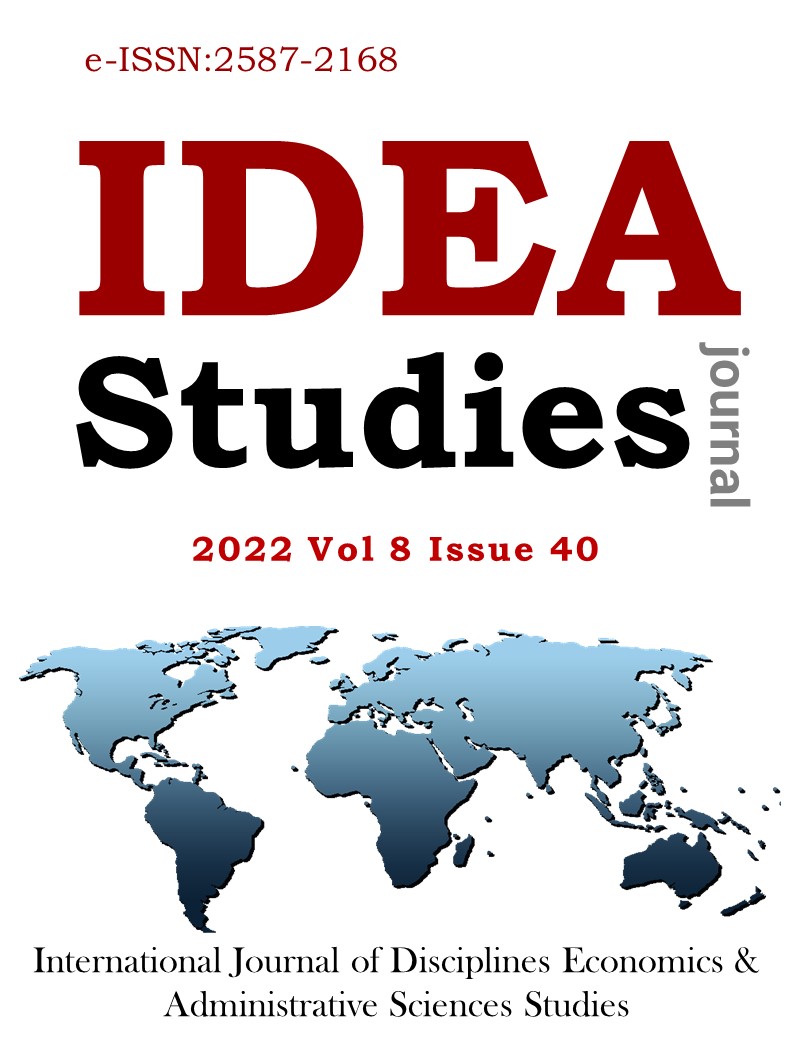Author :
Abstract
COVID-19 salgını ile birlikte bireylerin sağlık davranışlarının önemi bir kez daha anlaşılmıştır. Aşırı kilolu, sigara içen ve düzenli egzersiz yapmayan bireylerin salgından daha çok olumsuz etkilendiği bilinmektedir. Bu süreçte sağlık davranışlarını iyileştirebilecek yaklaşımların belirlenmesine ihtiyaç olduğu görülmektedir. Bu çalışmada bu yaklaşımlardan biri olabileceğini düşündüğümüz Hasta Aktiflik Düzeyini (HAD) ele aldık ve HAD'ın sağlık davranışları ile ilişkisini inceledik. Kolayda örnekleme yöntemi kullanılmıştır. Araştırmanın örneklemini Kahramanmaraş ilindeki üniversite hastanesine gelen 402 hasta oluşturmuştur. Tanımlayıcı istatistikler ve t-testi tekniği kullanılmıştır. HAD skorları yüksek olan hastaların, en düşük HAD skorlarına sahip hastalara kıyasla, daha fazla egzersiz yapma ve daha az sigara kullanma olasılıkları anlamlı derecede daha yüksekti. Benzer şekilde, hasta aktivasyonu yüksek olan bireylerin daha az kilolu olduğu bulundu. Bu veriler ışığında, hasta aktiflik düzeyinin artırılmasının, bireylerin iyilik hallerinin iyileştirilmesi için ülkeler tarafından çok önemli bir politik araç olarak görülmesi gerektiği ifade edilebilir. Hastalar için broşürler ve eğitim videoları hazırlamak, aktiflik düzeyini artırmak için önemli bir etkiye sahip olabilir.
Keywords
Abstract
The importance of health behaviors was once again clearly understood during the COVID-19 pandemic. Individuals who are overweight, smokers and do not exercise regularly were affected much more negatively by the epidemic. In this process, there is a need to identify approaches that can improve health behaviors. In this study, we evaluated the patient activation measure (PAM), which we think may be one of these approaches and we examined PAM's association with health behaviors. The convenience sampling method were used. 402 patients who came to the university hospital in Kahramanmaraş, Turkey formed the sample of the study. Descriptive statistics and t-test technique were used. Patients with high PAM scores were significantly more likely to perform more exercise and use less smoked, compared to patients with the lowest PAM scores. Similarly, it was found that individuals with high patient activation weighed less. In the light of these data, it can be stated that increasing patient activation should be considered as very significant political instrument by countries for improving the well-being of individuals. Preparing leaflets and educational videos for patients could have a significant impact to increase the level of activation.
Keywords
- Alegría, M., Polo, A., Gao, S., Santana, L., Rothstein, D., Jimenez, A., Hunter, M. L., Mendieta, F., Oddo, V., &Normand, S.-L. (2008). “Evaluation of a Patient Activation and Empowerment Intervention in Mental Healthcare”, Medical Care, 46(3):247-256. https://doi.org/10.1097/MLR.0b013e318158af52
- Balci, H., & Küçükkendİrci, H. (2019). “Obezite ve Obezite Cerrahisinde Beslenme”, Türk Bilimsel Derlemeler Dergisi, 12(2):45-50. https://www.derleme.gen.tr/index.php/derleme/article/view/333
- Buturak, Ş. V., Günal, N., Özçiçek, G., Rezaki, H. Ö., Koçak, O. M., Kırıcı, A. G., Kabalcı, M., Dural, K., &Özpolat, B. (2016). “Sigara Bırakma Polikliniğine Başvuran Hastaların Sosyodemografik Özellikleri ve SigaraBağımlılık Şiddetleri”, Turkish Journal of Clinics and Laboratory, 7(1):72-76. https://doi.org/10.18663/tjcl.05665
- Deen, D., Lu, W.-H., Rothstein, D., Santana, L., & Gold, M. R. (2011). “Asking Questions: The Effect of aBrief Intervention in Community Health Centers on Patient Activation”, Patient Education and Counseling, 84(2):257-260. https://doi.org/10.1016/j.pec.2010.07.026
- Frosch, D. L., Rincon, D., Ochoa, S., & Mangione, C. M. (2010). “Activating Seniors to Improve ChronicDisease Care: Results from a Pilot Intervention Study”, Journal of the American Geriatrics Society, 58(8):1496- 1503. https://doi.org/10.1111/j.1532-5415.2010.02980.x
- Greene, J., & Hibbard, J. H. (2012). “Why Does Patient Activation Matter? An Examination of theRelationships between Patient Activation and Health-Related Outcomes”, Journal of General Internal Medicine, 27(5):520-526. https://doi.org/10.1007/s11606-011-1931-2
- Greene, J., Hibbard, J. H., Sacks, R., Overton, V., & Parrotta, C. D. (2015). “When Patient Activation LevelsChange, Health Outcomes and Costs Change, Too”, Health Affairs, 34(3):431-437. https://doi.org/10.1377/hlthaff.2014.0452
- Harvey, L., Fowles, J. B., Xi, M., & Terry, P. (2012). “When Activation Changes, What Else Changes? TheRelationship between Change in Patient Activation Measure (PAM) and Employees’ Health Status and Health Behaviors”, Patient Education and Counseling, 88(2):338-343. https://doi.org/10.1016/j.pec.2012.02.005
- Hibbard, J. H., Greene, J., & Tusler, M. (2009). “Improving the Outcomes of Disease Management by TailoringCare to the Patient's Level of Activation”, The American Journal of Managed Care, 15(6):353-360. https://europepmc.org/article/med/19514801
- Hibbard, J. H., Mahoney, E. R., Stock, R., & Tusler, M. (2007). “Do Increases in Patient Activation Result inImproved Self‐Management Behaviors?”, Health Services Research, 42(4):1443-1463. https://doi.org/10.1111/j.1475- 6773.2006.00669.x
- Hibbard, J. H., Mahoney, E. R., Stockard, J., & Tusler, M. (2005). “Development and Testing of a Short Formof the Patient Activation Measure”, Health Services Research, 40(6p1):1918-1930. https://doi.org/10.1111/j.1475- 6773.2005.00438.x
- Measure (PAM): Conceptualizing and Measuring Activation in Patients and Consumers”, Health Services Research, 39(4p1):1005-1026. https://doi.org/10.1111/j.1475-6773.2004.00269.x
- Isralowitz, R., Afifi, M., Reznik, A., & Sussman, S. (2016). Cigarette Smoking Among Youth: A Regional Health Problem. In Mental Health and Addiction Care in the Middle East (pp. 93-107). Springer.
- Kaya, F., Şimşek, B., & Erzeybek, M. S. (2018). “Güneydoğu Anadolu’da Genç Nüfusun Spor Yapma veFiziksel Aktiviteye Katılma Eğilimleri: Batman İl Örneği, Türkiye”, Spor Eğitim Dergisi, 2(1):21-28. https://dergipark.org.tr/en/pub/seder/issue/35879/396841
- Kim, J. Y., Wineinger, N. E., & Steinhubl, S. R. (2016). “The Influence of Wireless Self-Monitoring Programon the Relationship between Patient Activation and Health Behaviors, Medication Adherence, and BloodPressure Levels in Hypertensive Patients: A Substudy of a Randomized Controlled Trial”, Journal of Medical Internet research, 18(6):1-14. https://doi.org/10.2196/jmir.5429
- Kopelman, P. G. (2000). “Obesity As a Medical Problem”, Nature, 404(6778):635-643. https://doi.org/10.1038/35007508
- Kosar, C., & Besen, D. B. (2019). “Adaptation of A Patient Activatıon Measure (PAM) into Turkish: Reliability and Validity Test”, African Health Sciences, 19(1):1811-1820. https://doi.org/10.4314/ahs.v19i1.58
- Mosen, D. M., Schmittdiel, J., Hibbard, J., Sobel, D., Remmers, C., & Bellows, J. (2007). “Is patient ActivationAssociated with Outcomes of Care for Adults with Chronic Conditions?”, The Journal of Ambulatory Care Management, 30(1):21-29. https://doi.org/10.1097/00004479-200701000-0005
- Sarkar, J., & Sil, P. (2017). “Benefit of Exercises on Health: Study of Health Status of Young Adult WomenParticipating Exercise Regularly”, Nutrition and Physical Education, 3(2):342-344. https://www.journalofsports.com/pdf/2017/vol2issue1/PartF/2-1-81-323.pdf
- WHO (2000). Obesity : preventing and managing the global epidemic : report of a WHO consultation. World Health Organization. https://apps.who.int/iris/handle/10665/42330
- Williams, G. C., McGregor, H., Zeldman, A., Freedman, Z. R., Deci, E. L., & Elder, D. (2005). “PromotingGlycemic Control through Diabetes Self-Management: Evaluating a Patient Activation Intervention”, Patient Education and Counseling, 56(1):28-34. https://doi.org/10.1016/j.pec.2003.11.008





